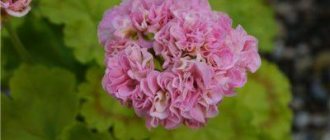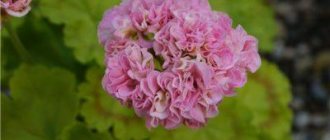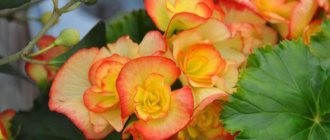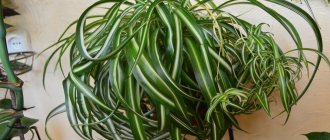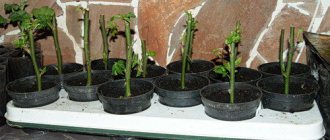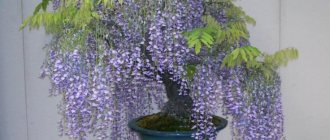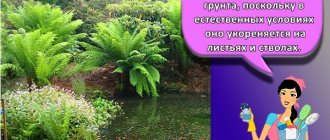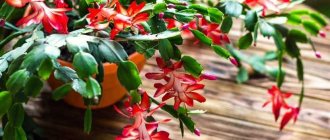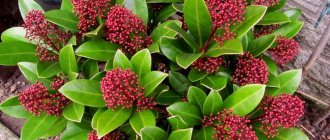Botanical description and history
Norland is a double, zonal geranium, the distinctive feature of which is considered to be increased decorativeness. This is a hybrid that can be grown both on a windowsill and in open ground. Some seed producers attribute this variety to rosebuds, but this is not so - it is a zonal pelargonium species.
Northland is a fairly unpretentious species; it requires standard care and watering. The only difficulty that a novice gardener may encounter is the formation of a bush.
Where and how to plant it?
If you decide to plant this flower with seeds, then no one will give you clear recommendations on sowing. Experts advise sowing seeds in spring or summer, when there is a lot of heat and sunlight.
Experienced flower growers consider the best time for planting to be early March. Then the first buds can be seen already in July. Others say that sowing should be done in late November or early December, arguing that when germinating seeds, sunlight is not necessary, and when seedlings appear, lighting can be installed. Therefore, they are engaged in seedlings almost all year round. It is worth noting that geranium will grow to medium size in about 4-5 months.
Lighting and location
Like all pelargoniums, Norland needs to be sanctified; there should be a lot of light, but direct sunlight can leave burns on the leaves and flowers. Therefore, at noon you need to arrange shading; the rest of the time the light should be good and diffused.
Both direct sunlight and lack of light have the same effect on pelargonium - it refuses to bloom. At the same time, lush greenery is formed.
Norland is a variety that does not tolerate stuffiness; the optimal temperature for good growth and rapid flowering is + 18-23 degrees in summer, while +12 is enough in winter. Open air has a beneficial effect on geraniums, which is why they are placed on a terrace, balcony or in the garden for the summer.
Soil requirements
The soil for zonal pelargoniums needs to be very nutritious, fertile, and rich in microelements. You can buy it in a store or make it yourself. The composition of the soil is as follows:
- 2 parts peat;
- 2 parts leaf soil;
- 1 part coarse sand.
Drainage is very important to the plant. Pelargonium does not like stagnation of water in the pot, as the roots rot and the plant dies. Expanded clay, fine pebbles, crushed brick, fine gravel, and so on are used as drainage. The roots of the plant need oxygen, so the earthen ball must be constantly loosened.
Advice. You should not add a lot of peat to the soil, it retains moisture - the soil will be constantly waterlogged.
Popular types and varieties of pelargonium
Pelargonium mallorca
A cactus variety of flower, belongs to the zonal type. The flowers are very bright, two-tone: pink alternating with red. The petals are jagged, of unusual shape, with pointed edges. Selected varieties may have a combination of shades of white and pink and white and red. It is considered dwarf because it does not exceed 30 cm in height; it is grown as an ornamental plant at home.
Pelargonium lotta lundberg
Another representative of zonal pelargonium received the name “Star-shaped” because of its unusual flowers. The dwarf variety has rather large, spherical inflorescences of bright crimson color. All petals are pointed and velvety to the touch. The leaves are a contrasting dark green with brown veins.
Pelargonium Richard Hudson
The inflorescence consists of many small flowers of various pink shades. The edge of each petal smoothly turns into dark pink, less often red. A specially bred hybrid variety that can withstand the minimum temperatures for this type (around 0 degrees Celsius). It is used exclusively as an ornamental houseplant, although it can also grow in the garden.
Pelargonium bold gold
Bold Gold is one of the most common varieties of pelargonium and blooms all year round. The flowers are predominantly pink with a thin purple edge. The yellow-green leaves are often called golden leaves. The trunk of the plant is very branched; with proper pruning, compact semicircular spherical bushes are obtained.
Pelargonium Passat
Terry zonal pelargonium, the peculiarity of which is a large number of umbrella inflorescences on thin stalks located above the level of the leaves. A very fastidious plant in terms of care, it constantly requires pruning. With proper care, one dwarf bush with 5-8 large inflorescences will bloom all summer.
Pelargonium Bold Minstrel
A fairly small indoor plant that requires virtually no pruning. The bush of the plant forms independently in the form of a hemisphere, the top of which is crowned with bright pink flowers. The medium-sized leaves contrast very strongly with the huge ball buds. As a rule, 3-4 large inflorescences bloom at the same time. Requires daily watering.
Pelargonium Elmsett
"Velvet leaf", or Elmsett pelargonium, is very popular among florists who are interested in growing pelargoniums. One of the smallest representatives of the dwarf varieties has creamy pink flowers and light green leaves. When exposed to the sun for a long time, the leaves of this variety change color to burgundy-red or gold, so it is best to keep it in the shade. Blooms all year round.
Pelargonium Diana Palmer
Diana Palmer flowers, at first glance, resemble carnations in pink, cream or pale red. The edges of the petals are jagged and velvety. The heat-loving variety, when the air temperature in the room drops to +10 degrees, goes into hibernation. With good care, it blooms very actively all year round and does not require pruning.
Pelargonium Bold Pixie
The very bright double flowers of this zonal pelargonium immediately catch the eye thanks to their rich crimson color. The foliage is medium in size and dark green in color, only emphasizing the beauty of the inflorescences. The velvety tips of the petals are jagged. From 4 to 12 inflorescences can bloom simultaneously on one bush.
Pelargonium Bold Carmine
It is very easy to confuse Carmine with Pixie - both flowers are bright pink. The main difference is that the edges of Carmine's petals are rounded rather than jagged. This variety is semi-double, the bush is small, even miniature. The peduncles are very long and end with 3-4 flower balls. Closer to autumn it requires a little pruning. When grown indoors, frequent watering is required.
Pelargonium Bridesmaid
Bridesmaid flowers come in shades of pink, crimson, cream and orange. The leaves are light green, the edges of which gradually turn yellow. The inflorescences are very crowded, knocked down, and have an irregular round shape. The petals are velvety, round in shape.
Pelargonium Carousel
Large pink flowers will be a wonderful decoration for a balcony or windowsill. Another zonal semi-double variety. The inflorescences are very dense and always rise above the bush. A distinctive feature of this flower is the presence of a darker eye in the center. If you take proper care, the plant will be covered with delicate spherical flowers by mid-summer.
How to properly care?
Pelargonium Norland - grows and blooms well in a pot on the windowsill, but in order for the flowering to be abundant, you will have to take care of it. The rules are not complicated, but in order for the plant to be strong and healthy, it is advisable to follow them unquestioningly.
Watering
In summer, watering should be plentiful and very frequent, since during hot periods pelargonium flower buds may fall off due to lack of moisture. But at the same time, you should not over-water the plant, and if moisture has accumulated in the pan after watering, it must be drained - this will prevent rotting of the roots.
When watering, use only settled, soft water that does not contain limescale. There is no need to spray pelargonium during flowering; it can not only lose its decorative effect, but also rot.
Top dressing
For Norland pelargonium, only mineral fertilizers are applicable. Feeding the plant is strictly prohibited. But this applies not only to this variety; all geraniums have a negative attitude towards organic fertilizers. It is better to apply mineral complexes during the period of active growing season and rapid flowering. Feeding is done once every 2 weeks in summer. As for the winter period, there is no need to add additional food.
Transfer
Pelargonium does not like frequent transplants , so it is obviously better not to touch it until the pot becomes cramped. This is very easy to determine - the roots of the plant will stick out from the drainage holes.- When replanting, you should not take a large pot - pelargonium will stop blooming; each new pot should be 1.5 cm larger than the previous one. Flowering begins only after the earthen ball is completely filled with roots.
- The soil in the pot must be completely replaced . To do this, carefully free the roots from the old soil, trying not to damage them, then transfer the pelargonium to the new soil. After replanting, fertilizing is not carried out for a month and a half, since the new soil is already nutritious.
- You cannot touch the plant during the active growing season ; you need to wait until the pelargonium fades and goes into a dormant state. It will also tolerate transplantation well in early spring.
Attention! Many gardeners claim that after pelargonium grows to 30 cm in height, it is no longer necessary to replant it.
Trimming
Pelargonium Norland needs high-quality and regular pruning. This is the only way to form a beautiful, compact and dense bush with large double flowers.
This process is carried out in the spring, the shoots are shortened by a third. Pruning allows you to stimulate the flower to form new shoots and bloom luxuriantly. If you do not pinch and trim, the geranium will stretch tall, the lower leaves will fall off the stems and you may not even get flowers. In the fall, dry and weak shoots are removed from the bush so that during the dormant period the pelargonium gains strength for new flowering.
Video tutorial on pruning pelargonium:
Description of varieties
Pelargonium Bold includes many varieties that are very popular.
Carmine
Carmine belongs to the zonal group. The plant produces large flowers of double and semi-double type. They are characterized by a red-crimson color. This pelargonium is compact. Judging by the reviews, the plant blooms well even in November. Some gardeners note that the variety sometimes has a carmine-red tonality. It is also worth considering that, despite the pleasant colors, the size of the flower cap may seem insufficient to most breeders. But even at the same time, the plant looks attractive.
Pixie
It is appropriate to pay attention to Pixie. The culture grows slowly and forms only dwarf plants
But they are decorated with juicy purple double flowers. The flowers can also be painted in a raspberry-pink tone. The foliage is a flawless green color.
Diamond Wedding
Diamond Wedding is a pelargonium that produces round, double flowers. Blooming buds are grouped into dense caps. The predominant color is airy pink, distinguished by its tenderness. The foliage is bright green and not too large in size. The bushes stand out for their density.
Minstrel
The Minstrel variety has a large number of positive reviews. They bloom profusely. The flowers are bright pink. The bush is very compact. This pelargonium forms powerful peduncles of short length. Flowering begins very early. Rarely any other variety of pelargonium can boast of this property. Judging by the comments of flower growers, non-stop formation of buds is possible for 2.5 months in a row. Moreover, the buds form lush caps of double flowers. Each time during flowering, 3 or 4 caps appear. The flowers bloom almost simultaneously. There is also more than enough foliage. Even the most meticulous observers fail to detect flaws. But in return, the plant will require intensive watering and good fertilizing.
Sunrise
Variety Sunrise is a pelargonium with large double flowers of salmon color. White veins are clearly visible on them. The edges of the petals are slightly lighter. The inflorescences reach enormous sizes. The Sunrise pelargonium bush is very dense and stocky. The flower is unpretentious.
Beacon
The Beacon variety is very beautiful. Quite a lot of flowers are formed. They are painted a deep cherry color. There are scarlet inclusions on the upper petals. The inflorescences are bright and large. The plant develops well and does not require any particularly difficult conditions.
"Bold Gold"
Pelargonium "Bold Gold" has light green leaves. When kept in full sun, an attractive dark zone appears. Growth occurs relatively slowly. Pruning and pinching is quite reasonable. Judging by the reviews, “Bold Gold” tolerates the heat calmly.
Limelight
Pelargonium Limelight is one of the standard varieties. If time for formation is not lost, the plant will bush well. The flowers reach a colossal size and are of the semi-double type. They are characterized by a pink color
Important: flower growers who do not like pompous specimens should take a closer look at other varieties
Bold Princess
Bold Princess is a dwarf plant of a desaturated pink color. It is characterized by good bush formation. Flowering lasts a long time and is abundant. In the first half of September, when there is not so much sun, the flower becomes brighter, and the edge of the petals receives a kind of border. The petals almost never fall off.
"Bold Ann"
“Bold Ann” is a pelargonium that is distinguished by its beauty and compactness of the bush. He is relatively short in stature. Large caps are held on strong peduncles. The plant is not capricious.
"Bold Carmine"
"Bold Carmine" is a much more capricious plant. It belongs to the average height group. It has bright, small leaves. This pelargonium may suffer from blackleg infection, and if it is hot, it may even die. But even when transplanted on a hot day, the plant develops well. True, you can’t expect beautiful flowering in the same year. The winter will go quite well. Full growth will begin in the spring.
Common diseases and pests
There is no house plant that is not subject to disease and pest attacks, and Norland pelargonium is no exception. What infections and insects can harm the plant:
Gray mold is the most common disease of fungal origin, which spreads very quickly.
The first sign of gray rot is spots that can appear on any part of the flower; the leaves are the first to be affected, then the stems and inflorescences. A parasitic fungus develops if there is a lot of nitrogen and moisture in the soil. Fungicides will help cope with the disease: Vitaros, Rovral, Fundazol.- Root and stem rot - by the name you can understand which parts of the plant they affect. The reason is also waterlogging.
- Whitefly, mealybug - a plant affected by these insects stops growing, loses its decorative appearance, withers, and if not controlled, may die. To combat, you need to use special chemicals - insecticides.
Reference. Pelargonium is rarely attacked by insects due to its specific smell.
Features of reproduction
The most common method of propagating pelargonium is cuttings, and we will consider it. If you decide to cut a cutting from the mother plant, then it is better not to let it bloom for a year, this is the only way the planting material will be strong and healthy. If everything is done correctly, then this same summer the young plants will delight you with their flowering.
The algorithm of actions is as follows:
- Shoots for propagation are cut in March, using a sharp, sterile instrument. The cut is made at an angle of 45 degrees. You need to leave 2-3 internodes on the cuttings.
- The cuttings are dried in air for 10 hours.
- Remove leaves from the bottom of the prepared cuttings, otherwise they may rot in the ground.
- The cuttings are immediately placed in soil, which consists of sand, soil, perlite and vermiculite. Before planting, the substrate is moistened.
- Cover the cuttings with a glass jar, and do not forget to ventilate every day.
- The roots of the shoot will appear in about a week and a half. Immediately after this, the jar is removed, and the young plant is fed with a mineral complex.
Pelargonium is a beautiful and fragrant plant that is suitable for indoor and outdoor cultivation. You can view our materials about other varieties Bold, Clara Sun, Grandiflora, Richard Hudson, Zonartik, Prince Gustav, Mildfield Rose, Patricia Andrea, Salmon, Lady Gertrude on our website.
Pelargonium Norland is a flower that is loved in many countries. The decorative qualities of the plant and ease of care make it possible to grow this beautiful flower everywhere.
The process of propagating pelargonium by cuttings
Pelargonium Viva Rosita can be propagated in several ways - by seeds or cuttings. It is better to carry out the procedure from February to March or from July to August.
The process is carried out as follows:
- A shoot about 7 cm long is cut from an adult plant. It must have at least 3 leaves.
- The cuttings are lightly dried and placed in a container with prepared soil.
- Water along the edge of the pot.
- After a couple of weeks, rooting will occur.
- If desired, you can place the shoot in a glass of water and wait until it has roots.
Attention! Propagation by cuttings allows you to get a new and strong plant in a fairly short time.
Pelargonium is a very decorative flower

